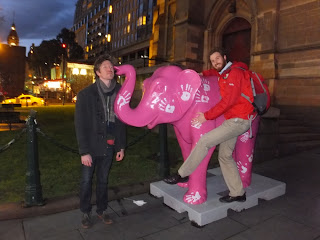 |
| You've got to love the warning signs! |
We had a lovely and really well kitted out campsite where we based ourselves for 2 nights so that we could explore the area. Unfortunately the weather was pretty wild with low temperatures and huge rain and hail storms so we were glad to have nice facilities out of the weather to cook and eat in. Our little tent did well in the rough weather.
 |
| Yum! Eucalypt leaves for breakfast... rather you than me, fella! |
 |
| A cold, wet ball of koala. |
 |
| They were literally hanging in the trees like Christmas decorations. |
 |
| Mother and joey |
 |
| It was amazing how they defoliated (ate all the leaves) off the trees that they were in. |
 |
| We were mightly glad for all our warm clothing! |
 |
| How they managed to stay on the branches while they slept was amazing. Even more so in the howling wind! |
 |
| Every 3rd fork in the tree had a fluffy koala sleeping in it! |
 |
| Another mom and her baby feeding high up on the thin branches |
 |
| They were fascinating to watch |
 |
| The forest around the campsite was lovely. |
We had read up about the lighthouse at Cape Otway and were keen to visit it. It is the oldest surviving lighthouse in Australia and was built in 1948 by more than 40 stonemasons without any mortar or cement! The lighthouse stands guard over the point where the Bass Strait and the Southern Ocean meet and was often the first land to be seen by people sailing from Europe to 'the New Land'. Unfortunately we felt the entrance fee was rather steep, so we had to settle for a glimpse of the lighthouse from a walk nearby.
 |
| Cape Otway lighthouse. |
We found a beautiful little cove called Blanket Bay for lunch and watched some Southern Right whales playing in the bay. The surf was huge and the sea of the type that brings the words of John Masefield's Sea Fever to mind.
 |
| The little estuary at Blanket Bay |
 |
| The remote and beautiful Johanna Beach. |
Sea Fever by John Masefield
I must go down to the seas again, to the lonely sea and the sky,
And all I ask is a tall ship and a star to steer her by,
And the wheel's kick and the wind's song and the white sail's shaking,
And a grey mist on the sea's face, and a grey dawn breaking.
I must go down to the seas again, for the call of the running tide
Is a wild call and a clear call that may not be denied;
And all I ask is a windy day with the white clouds flying,
And the flung spray and the blown spume, and the sea-gulls crying.
I must go down to the seas again, to the vagrant gypsy life,
To the gull's way and the whale's way, where the wind's like a whetted knife;
And all I ask is a merry yarn from a laughing fellow-rover,
And quiet sleep and a sweet dream when the long trick's over.
And all I ask is a tall ship and a star to steer her by,
And the wheel's kick and the wind's song and the white sail's shaking,
And a grey mist on the sea's face, and a grey dawn breaking.
I must go down to the seas again, for the call of the running tide
Is a wild call and a clear call that may not be denied;
And all I ask is a windy day with the white clouds flying,
And the flung spray and the blown spume, and the sea-gulls crying.
I must go down to the seas again, to the vagrant gypsy life,
To the gull's way and the whale's way, where the wind's like a whetted knife;
And all I ask is a merry yarn from a laughing fellow-rover,
And quiet sleep and a sweet dream when the long trick's over.







































